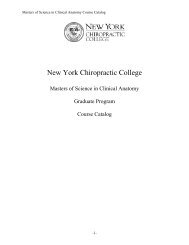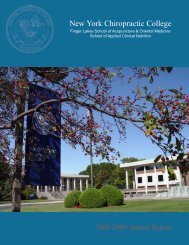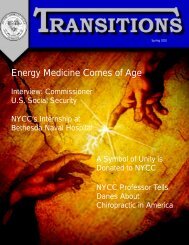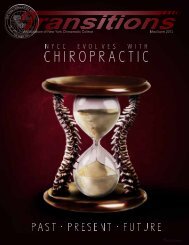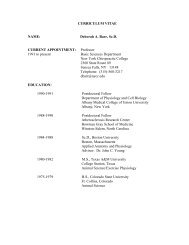2502 NYCC TRANS FINAL2 - New York Chiropractic College
2502 NYCC TRANS FINAL2 - New York Chiropractic College
2502 NYCC TRANS FINAL2 - New York Chiropractic College
Create successful ePaper yourself
Turn your PDF publications into a flip-book with our unique Google optimized e-Paper software.
Interview With: Howard F. Loomis, Jr., D.C., F.I.A.C.A.<br />
Howard F. Loomis, D.C., president of Enzyme Formulations, Inc., majored<br />
in chemistry at the State University of <strong>New</strong> <strong>York</strong> at Buffalo and is a<br />
1968 graduate of Logan <strong>Chiropractic</strong> <strong>College</strong>. Dr. Loomis’s interest in nutritional<br />
food enzymes began when he had the privilege of working with Edward<br />
Howell, M.D., the food enzyme pioneer. His broad knowledge of human physiology<br />
and nutrition, plus his practical experience with various testing and treatment<br />
modalities, contribute to Dr. Loomis’s expertise on the clinical application<br />
of nutritional food enzymes. He is currently lecturing on the benefits of Enzyme<br />
Replacement Therapy(TM) and has articles appearing monthly in The <strong>Chiropractic</strong><br />
Journal and The American Chiropractor. As president of 21 st Century<br />
Nutrition, Dr. Loomis educates people worldwide regarding diagnosis and treatment<br />
of enzyme deficiency syndromes. Dr. Loomis may be contacted at 800-<br />
662-2630 and supports an internet website at www.loomisenzymes.com.<br />
Transitions recently had the good fortune to interview Dr. Howard<br />
Loomis. Throughout an interview that ultimately focused upon nutrition,<br />
Dr. Loomis recounted a variety of functions common to all<br />
of life – ranging from the lone cell to entire living organisms. The<br />
functions he mentioned included, among others, reproduction, respiration,<br />
digestion, elimination and protection. His tracing the development<br />
of multicellular organisms helped clarify the important<br />
interrelationship between bodily systems and nutrition’s vital role in<br />
maintaining health. According to Dr. Loomis, cells that organize<br />
into “communities” specialize and form distinct organ systems. While<br />
the amoeba exists in an external environment, humans and other<br />
multicellular organisms are required to maintain internal environments<br />
in which the various bodily cells can function. Organs and<br />
organ systems work to sustain specifically defined internal environments.<br />
Relevant environmental conditions would include temperature,<br />
acid/base balance, nutrient concentration, and oxygen/nutrient<br />
flow.<br />
Mechanical, chemical/nutritional, and emotional stresses that<br />
challenge the various organ systems increase demand for nutrients<br />
and create additional wastes. Ultimately, when the organ systems can<br />
Cancer and Obesity<br />
The World Health Organization (WHO)<br />
reported that obesity and lack of exercise<br />
were major factors in up to one third of<br />
cases of cancer of the colon, breast,<br />
kidney, and digestive tract. While there<br />
are few studies indicating that weight<br />
reduction reverses the risks, WHO<br />
advocates active weight loss among<br />
persons with a body mass index above 25.<br />
no longer meet the stressful challenges,<br />
symptoms begin to appear.<br />
Additional compensatory<br />
organ systems are then called<br />
upon that may exhaust themselves<br />
in the process. Eventually,<br />
exhaustion may result in measurable<br />
pathological changes. It is<br />
at this advanced stage that medicine<br />
may finally identify and assess<br />
damage and, consequently,<br />
begin treatment.<br />
Due to their unique training,<br />
chiropractors often recognize the<br />
onset of health problems before<br />
measurable damage. In this regard,<br />
subluxations will appear as<br />
Howard F. Loomis, D.C.<br />
effects of emerging health problems<br />
rather than as causes. For example, the chiropractor may palpate<br />
muscle contractions along nerves that connect the hypothalamus<br />
and stressed organs. Dr. Loomis believes the treatment and<br />
enhancement of digestion is a wide open healthcare opportunity for<br />
chiropractors. As he puts it, “No one out there is looking at it. And<br />
medicine will give it to chiropractors!” Considering the public’s annual<br />
expenditure for antacids, Dr. Loomis’ proposal may be very<br />
lucrative indeed.<br />
Transitions: I enjoyed your article “Key Issues in Geriatric Nutrition<br />
Part I: The Physiological Changes,” as reported in The American<br />
Chiropractor. I was struck by your remark that chiropractors are<br />
uniquely qualified to determine by case history, examination, and<br />
urinalysis, early deviations from homeostasis. Anti-aging expert, Dr.<br />
Philip Santiago, made similar reference to chiropractic’s unique position.<br />
Are chiropractors uniquely positioned because they have learned<br />
to not simply treat “symptoms,” or is it because the symptoms that<br />
medical doctors treat are already late-stage problems?<br />
Dr. Loomis: I believe chiropractors are uniquely suited to recognize<br />
potential health problems before they manifest themselves as<br />
disease entities. This is because of what they measure or what deviations<br />
from normal they recognize as problems. I left Logan <strong>College</strong><br />
in 1968 having been trained not to treat symptoms but rather to<br />
recognize the stress that was exhausting the body’s ability to maintain<br />
health.<br />
Allopathic physicians, on the other hand, must wait for demonstrable<br />
pathological changes to be recognized and a name placed on<br />
the process before they can initiate current therapy. In other words,<br />
symptom A = drug A = insurance code/payment A. Until that diagnostic<br />
parameter is met they can only guess at the appropriate remedy.<br />
This problem has led to the current state of advertising propaganda<br />
being funded by the pharmaceutical industry. In the late 1980s<br />
Continued on page 24<br />
www.nycc.edu<br />
15



